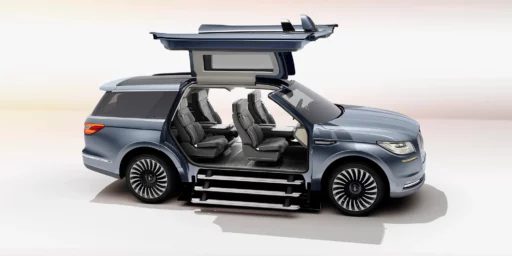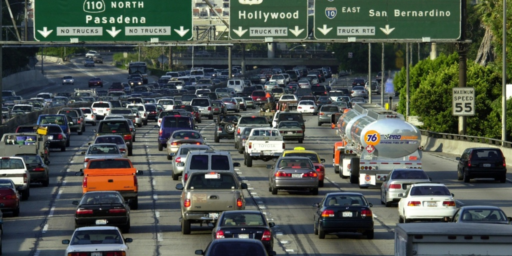E.P.A. Downgrades Gas Mileage Again
The E.P.A. has again changed its formula for calculating fuel economy to lower its mileage estimates.
The Environmental Protection Agency rewrote one of the great fictions of American life on Monday by changing the formula for calculating miles-per-gallon numbers on the window stickers of new cars, to take account of higher speeds, more aggressive driving, more air-conditioning use and other factors not in the old system. The rules cover 2008 models, some of which will be on sale next month. It does not change the actual mileage, only the advice to consumers. Congress ordered the change 18 months ago because of widespread dissatisfaction with the accuracy of the old numbers.
The system was last adjusted in 1984, when the E.P.A. cut the city values by 10 percent and the highway values by 22 percent. This one cuts the estimate of highway mileage another 8 percent, on average, and city mileage up to another 25 percent beyond the 1984 cut. Generally, the new formula narrows the gap between small cars and bigger vehicles, with small-car fuel economy estimates falling by more than the estimates for sport utility vehicles and other larger vehicles.
Hybrid vehicles will take some of the biggest hits, according to the agency, because the new standards include use of heaters and air-conditioners. Most gas-electric hybrids shut down their engines at low speeds, and run on electric batteries, but if the vehicle occupants have turned on the air-conditioner or heater, the engine may not shut down.
Actually, it does change the actual mileage. According to the EPA’s press release:
To provide American consumers with improved information when shopping for cars and trucks, EPA is issuing new methods to determine the miles per gallon (MPG) estimates that appear on new vehicle window stickers. The new standards will take effect for model year 2008 vehicles, which may be available for sale as soon as next month.
Also noteworthy and long overdue:
In addition to better fuel economy estimates, for the first time, EPA will be requiring fuel economy labeling of medium-duty vehicles, which are between 8,500 and 10,000 lbs., including large sport-utility vehicles and vans. Manufacturers will be required to post fuel economy labels on these vehicles beginning with the 2011 model year.
Given that most vehicles in this weight class are now driven by rappers rather than farmers*, it makes little sense to exclude them.
What’s interesting, though, is that people writing about fuel economy never mention that the metrics have changed. One can not fairly compare the gas mileage of vehicles from the 1970s, 1990s, and post-2008 without adjusting for the changing calculation formulas, yet it is done routinely.
[Update: CAFE standards are apparently not impacted by this change.]
Neither the press release nor the NYT account make it clear whether this change impacts the Corporate Average Fuel Economy (CAFE) standards. It would seem unreasonable to apply this new calculation to fleet averages when manufacturers were incentivized toward building and marketing more small and hybrid fuel vehicles. I’ve sent an inquiry to the E.P.A. requesting clarification on this point.
UPDATE: Apparently, this does impact CAFE:
Light Truck Fuel Economy Standard Rulemaking (Model Years 2008-2011)
This final rule reforms the structure of the Corporate Average Fuel Economy (CAFE) program for light trucks and establishes higher CAFE standards for model year (MY) 2008-2011 light trucks. Manufacturers may comply with CAFE standards established under the reformed structure (Reformed CAFE) or with standards established in the traditional way (Unreformed CAFE) during a transition period of MYs 2008-2010. In MY 2011, all manufacturers will be required to comply with a Reformed CAFE standard. Under Reformed CAFE, fuel economy standards are restructured so that they are based on a measure of vehicle size called “footprint,” the product of multiplying a vehicle’s wheelbase by its track width. A target level of fuel economy is established for each increment in footprint. Smaller footprint light trucks have higher targets and larger ones, lower targets.
It reads as if there is an adjustment applied, however, so to synchronize the requirements and the formula. There is a detailed FINAL REGULATORY IMPACT ANALYSIS [PDF].
A mockup with explanation of the new window sticker.
UPDATE: E.P.A. press spokesman John Millett says, “This action does not affect CAFE. That authority rests with the Transportation Department.” Now I’m really confused.
UPDATE: Now I see the problem: The documents linked in my first update, which were on the E.P.A. page announcing this change, are to DOT pages. They refer only to the fact that light trucks and SUVs formerly excluded from CAFE requirements are now included along with passenger cars. My apologies for the confusion.
_____
*Humorous hyperbole; not an actual statistic.






Given that most vehicles in this weight class are now driven by rappers rather than farmers*, it makes little sense to exclude them.
There must be a lot of old white rappers in suburbia then because thats about the only group I see foolish enough to buy them…life is not exactly like the videos on mtv you realize?
thanks james, you made my day. this action is overdue! it really angers me to buy a new car and not get the city mileage in careful small town driving. honesty is prefered over disappointment anytime!